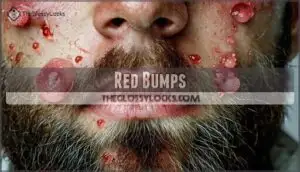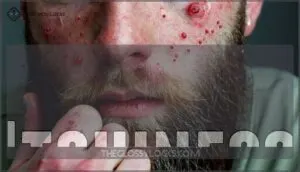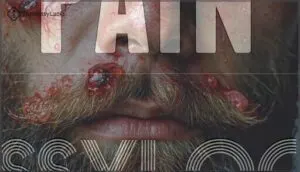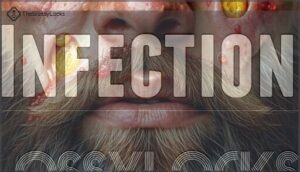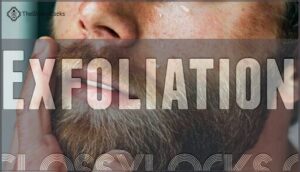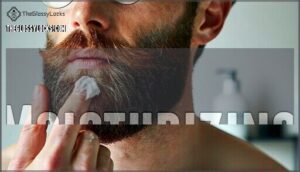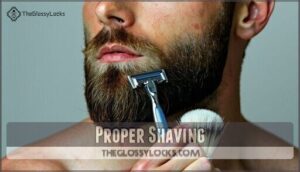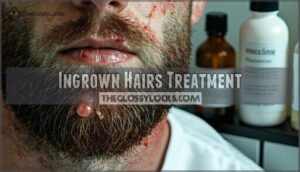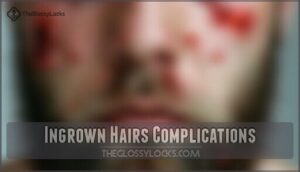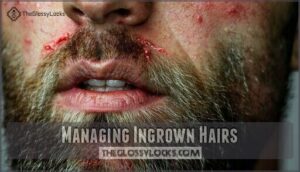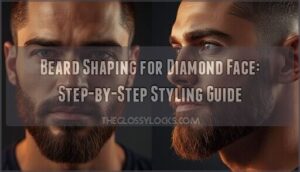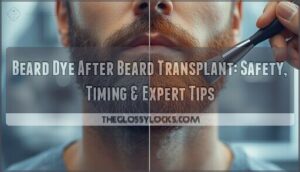This site is supported by our readers. We may earn a commission, at no cost to you, if you purchase through links.
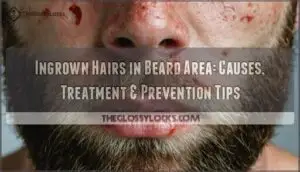
You’ll notice red, bumpy patches that feel tender and sometimes itchy.
Poor shaving technique is the main culprit – pressing too hard, using dull blades, or shaving against the grain forces hair to retreat under your skin.
Men with coarse or curly hair face this more often since their hair naturally wants to curl.
The good news is that you can break free from this cycle with the right approach to shaving and skin care that keeps your follicles clear and your face smooth.
Table Of Contents
- Key Takeaways
- Ingrown Hairs Causes
- Ingrown Hairs Symptoms
- Ingrown Hairs Prevention
- Ingrown Hairs Treatment
- Ingrown Hairs Complications
- Managing Ingrown Hairs
- Frequently Asked Questions (FAQs)
- How to get rid of ingrown hair in beard?
- How do you treat an ingrown beard?
- Do ingrown beard hairs fix themselves?
- What naturally draws out an ingrown hair?
- How long do ingrown beard hairs last?
- Can ingrown hairs cause permanent beard damage?
- What foods help prevent ingrown beard hairs?
- Are electric razors better for ingrown hairs?
- When should I see a dermatologist?
- Conclusion
Key Takeaways
- Perfect your shaving technique – You’ll prevent most ingrown hairs by using sharp, single-blade razors and always shaving with the grain, not against it, while applying proper pre-shave prep to soften hair.
- Exfoliate regularly but gently – You need to remove dead skin cells 2-3 times per week using gentle scrubs or chemical exfoliants like salicylic acid to keep your follicles clear and prevent hair from getting trapped.
- Don’t pick or squeeze bumps – You’ll make things worse and risk permanent scarring or infection, so instead apply warm compresses and let ingrown hairs resolve naturally over 1-2 weeks.
- See a dermatologist for persistent problems – You should get professional help if ingrown hairs last longer than two weeks, show signs of infection, or you’re dealing with chronic issues that might need prescription treatments or laser hair removal.
Ingrown Hairs Causes
You’re dealing with ingrown hairs because of how you shave and the natural characteristics of your facial hair.
Several factors work together to create these painful bumps, from your shaving technique to your hair’s texture and even your genetics.
Shaving Techniques
Your shaving technique directly impacts ingrown beard hairs development.
Sharp blades and proper technique prevent most ingrown hairs before they start.
Dull blades create jagged cuts that penetrate skin, while multi-blade razors lift-then-cut hairs causing triple the ingrowth risk.
Always shave with the grain using sharp, single blades.
Proper pre-shave prep softens hair, reducing trauma.
Quality post-shave care soothes irritation and prevents razor bumps beard formation.
This condition, known as pseudofolliculitis barbae, is common in men with tightly curled hair.
Curly Hair
Your curly beard creates a perfect storm for ingrown beard hairs.
The natural curl pattern makes hairs twist back into your skin as they grow, especially after shaving.
This happens because your hair’s porosity and moisture retention affect how it emerges from follicles.
Dead skin buildup can also contribute to this issue by clogging hair follicles.
Curly beard care requires gentle techniques to prevent beard bumps and support proper curl definition without triggering ingrown hair treatment needs.
Genetic Factors
Beyond your control, genetic factors substantially influence ingrown hair development.
Your ancestry predisposition matters—up to 76% of men with certain keratin gene mutations develop chronic ingrown hairs.
The A12T polymorphism in the K6hf gene increases risk sixfold.
Hormonal disorders like PCOS and medications from renal transplants also contribute to ingrown hair causes by affecting hair follicle behavior and coarse hair growth patterns.
Skin Conditions
Understanding how certain skin conditions contribute to beard ingrown hair development helps you break free from this frustrating cycle.
When your skin becomes a fortress of dead cells and thickness, hairs can’t escape properly.
Key skin conditions that trap beard hairs include:
- Keratosis pilaris – creates rough, bumpy skin texture
- Folliculitis – inflames hair follicles, blocking natural growth
- Dry, unexfoliated skin – forms barriers over follicle openings
- Chronic inflammation – alters follicle structure permanently
- Friction-induced thickening – from tight clothing or repeated irritation
These conditions create the perfect storm for ingrown hair beard problems, leading to hyperpigmentation, scarring, and skin infections if left untreated.
Ingrown Hairs Symptoms
Recognizing ingrown hair symptoms early helps you take action before they worsen or become infected.
You’ll typically notice small, red bumps that look like pimples, often with a visible hair trapped underneath the skin’s surface, which can lead to further infection.
Red Bumps
Red bumps are the hallmark sign of beard ingrown hair, appearing as small, inflamed spots that resemble pimples.
These beard hair bumps develop when hair curls back into skin, triggering your body’s defense response.
Razor bumps beard areas show varying severity levels.
| Bump Identification | Characteristics |
|---|---|
| Mild beard folliculitis | Small red spots, minimal pain |
| Moderate ingrown hair beard | Larger bumps, visible irritation |
| Severe razor bumps | Pus-filled, significant swelling |
When to worry: bumps with increasing pain, spreading redness, or fever need medical attention.
Initial response should focus on bump location assessment and avoiding further irritation.
Itchiness
Irritation strikes when trapped hairs trigger your skin’s inflammatory response, creating an uncomfortable cycle.
The beard area becomes particularly susceptible during stubble growth phases when coarse hairs push against sensitive skin.
- Itchiness Relief – Apply cool compresses and gentle moisturizers to calm inflamed follicles
- Scratching Risks – Avoid picking at bumps to prevent introducing bacteria and worsening beard folliculitis
- Underlying Causes – Dry skin and dermatitis can amplify itchiness alongside infected ingrown hair formation
- Managing Discomfort – Use anti-inflammatory products containing salicylic acid to reduce beard itchiness and promote healing
Pain
Throbbing pain can strike when ingrown hairs develop in your beard area, creating tender bumps that hurt when touched.
Those painful bumps aren’t just annoying—they’re your skin’s cry for help.
Pain intensity varies from mild discomfort to sharp, burning sensations that worsen with inflammation.
Chronic pain may persist if multiple painful ingrown hairs cluster together.
Effective pain management involves gentle care and avoiding further irritation to prevent prolonged discomfort, which is crucial for managing chronic pain.
Infection
Infected ingrown hairs escalate beyond simple irritation, creating painful, pus-filled bumps that demand immediate attention.
Bacterial infections thrive in these inflamed follicles, making infection prevention essential for your beard’s health.
Watch for these infection warning signs:
- Pus formation – Yellow or white fluid-filled bumps
- Increased pain – Throbbing or burning sensations
- Spreading redness – Inflammation beyond the original bump
- Warmth – Hot skin around affected areas
Treating infections early prevents antibiotic resistance and serious skin infections complications.
If symptoms worsen, it may indicate a severe skin infection.
Ingrown Hairs Prevention
You can prevent most ingrown beard hairs by following proper shaving techniques and maintaining healthy skin habits.
The key is avoiding overly close shaves and keeping your facial hair and skin properly conditioned to reduce irritation and inflammation, which helps in preventing ingrown hairs, and is crucial for healthy skin habits.
Exfoliation
Regular exfoliation removes dead skin cells that trap hairs beneath your skin.
You’ll want to exfoliate two to three times per week using gentle scrubs or chemical exfoliants like salicylic acid.
This keeps your follicles clear and reduces ingrown hair risk substantially.
Physical exfoliators can immediately remove dead skin.
| Exfoliation Methods | Benefits |
|---|---|
| Physical scrubs | Immediate dead skin removal |
| Chemical peels (AHA/BHA) | Deep pore cleansing |
| Exfoliating tools | Targeted beard area care |
Choose your exfoliation technique based on skin sensitivity.
Chemical peels work well for sensitive skin, while physical methods suit tougher skin types.
Post-exfoliation care involves gentle moisturizing to maintain your skin’s protective barrier.
Moisturizing
Moisturizing creates a protective shield for your skin, preventing irritation that leads to ingrown hairs. Think of it as armor against razor burn and inflammation. Pre-shave moisturizing softens hair and skin, while post-shave care restores hydration lost during shaving.
Many men find that using quality beard products helps maintain skin health.
- Hydration Importance: Well-moisturized skin stays flexible and less prone to follicle blockage
- Moisturizer Ingredients: Look for non-comedogenic formulas with soothing agents like aloe vera
- Application Frequency: Apply moisturizer daily and immediately after shaving for ideal skin barrier protection
- Post-Shave Care: Use cooling moisturizers or beard oil to calm inflammation and support healing
- Beard Grooming Tips: Incorporate moisturizing into your beard care routine for healthier skin underneath
Avoiding Tight Clothing
Tight clothing around your neck and collar creates friction that irritates freshly shaved skin, triggering inflammation and trapping beard hairs beneath the surface.
Choose loose-fitting shirts and avoid restrictive neckwear after beard hair removal.
This simple fabric choice reduces skin irritation and supports healthy circulation, preventing post-inflammation care needs and promoting effective ingrown hair prevention and overall skin irritation reduction.
Proper Shaving
Start with sharp blade quality and proper shaving cream to set yourself up for success.
Always shave with the grain direction, never against it, to prevent hairs from curling back into skin.
Pre-shave prep softens hair while aftershave care soothes irritation.
Many prefer using specialty shaving products for a smoother shave.
These shaving techniques using quality shaving products are essential for preventing ingrown hairs and avoiding shaving complications.
Ingrown Hairs Treatment
When ingrown hairs in your beard area become problematic, you’ll need targeted treatments to reduce inflammation and prevent infection.
Your doctor may recommend antibiotics for infected bumps, steroid medications to calm irritation, or laser hair removal for long-term relief.
Antibiotics
When bacterial infection strikes your beard area, topical antibiotics like clindamycin can tackle the problem head-on.
These medications reduce harmful bacteria while treating secondary infections that develop around ingrown hairs.
Oral antibiotics such as doxycycline work for severe cases, though antibiotic resistance remains a concern.
Watch for infection signs like pus or increased redness, and consider antiseptic treatments alongside antibiotics for effective healing.
Steroid Pills
When topical antibiotics aren’t enough, your dermatologist might prescribe steroid pills for severe beard inflammation.
These oral medications tackle widespread skin inflammation more effectively than creams alone. However, steroid side-effects require careful patient monitoring and dosage considerations.
Treatment duration typically stays short-term to minimize risks. Your dermatologist will weigh pill alternatives against steroid creams, ensuring safe management of stubborn shaving ingrown hairs.
Regular exfoliation prevents clogging of the hair follicles, which is a key step in preventing ingrown hairs.
Laser Hair Removal
For severe or recurring ingrown hairs, laser hair removal offers a permanent solution by targeting hair follicles with concentrated light.
This treatment destroys 80-90% of follicles per session, dramatically reducing future ingrown hairs while improving skin appearance.
- Laser effectiveness: Multiple sessions eliminate most hair growth permanently
- Treatment cost: Investment ranges from hundreds to thousands depending on area size
- Pain levels: Mild discomfort similar to rubber band snapping sensation
- Skin types: Works on most complexions, especially effective on dark hair
- Long-term effects: Permanent hair reduction prevents chronic ingrown hair cycles
Ingrown Hairs Complications
Ignoring ingrown hairs in your beard can lead to serious complications that affect both your appearance and health.
These issues range from permanent dark spots and scarring to painful infections that may require medical treatment, including those that lead to permanent damage.
Hyperpigmentation
Dark patches often follow the storm of ingrown hair inflammation.
Post-inflammatory hyperpigmentation affects up to 65% of people with darker skin tones, creating flat brown spots where melanin production goes into overdrive.
Your skin’s trying to heal, but it overcompensates, leading to hyperpigmentation treatment needs.
Vitamin C serums can help fade these stubborn marks by inhibiting melanin production and restoring your natural skin tone.
Scarring
Some people develop lasting marks when ingrown hairs heal improperly. Keloid Formation creates raised, smooth bumps that expand beyond the original wound, while physical trauma from picking increases scarring risk by 80%.
Proper scar prevention and treatment help minimize skin discoloration and keloid scars.
- Avoid picking or popping – Physical manipulation dramatically increases scarring severity
- Moisturize regularly – Keeps skin supple and reduces hyperpigmentation risks
- Use gentle exfoliation – Prevents scar tissue buildup without causing trauma
- Consider laser therapy – Professional scar treatment for stubborn keloid scars
Infections
Neglect transforms minor ingrown hairs into serious bacterial infections. You’ll face staphylococcus aureus infiltration when bacteria enter broken skin, creating pus-filled cysts requiring antibiotic treatment.
Home remedies offer relief for mild cases.
| Infection Stage | Symptoms | Treatment |
|---|---|---|
| Early bacterial infections | Warmth, redness, tenderness | Antibiotic ointment, warm compresses |
| Pus formation | Swollen, painful bumps with discharge | Oral antibiotics, drainage if needed |
| Advanced infection | Fever, spreading redness, systemic symptoms | Medical intervention, IV antibiotics |
Infection prevention starts with proper hygiene and avoiding picking at ingrown hairs. Treating infections promptly with appropriate antibiotic use prevents complications and promotes faster ingrown hair resolution.
Hair Loss
Beyond infections, chronic ingrown hairs can permanently damage hair follicles, disrupting your natural hair growth cycle.
This hair follicle damage leads to hair thinning and patchy beard growth.
Poor scalp health and nutritional deficiencies worsen hair loss from repeated ingrown hair removal.
Proper beard grooming and hair follicle care prevent beard itch while protecting against permanent follicle damage.
Managing Ingrown Hairs
When you’re dealing with ingrown hairs in your beard area, you’ll want to combine immediate relief with long-term prevention strategies.
The key is patience—rushing the healing process often makes things worse and can lead to scarring or infection.
Home Remedies
Several home remedies can ease razor bumps effectively.
Warm compresses for 10-15 minutes open pores and soften trapped hairs.
Gentle exfoliation with a washcloth removes dead skin cells that block follicles.
Apply tea tree oil or aloe vera to reduce inflammation naturally.
Daily moisturizer application keeps skin supple and prevents future ingrown hair issues.
Medical Intervention
When home remedies aren’t cutting it, it’s time to call in the pros.
Your dermatologist has an arsenal of prescription medications and advanced treatments to tackle stubborn pseudofolliculitis barbae that won’t budge.
- Prescription Medications: Steroid cream reduces inflammation while tretinoin helps prevent future breakouts
- Laser Therapy: Laser hair removal targets hair follicles for long-term relief from chronic cases
- Electrolysis Treatment: Destroys individual hair roots using controlled electrical current for permanent results
- Surgical Options: Dermatologist treatment may include minor procedures to remove deeply embedded hairs in severe cases
Preventing Future Ingrown Hairs
You’ll break free from ingrown hairs by mastering proper shaving techniques and choosing quality products.
Always shave in the Hair Growth Direction using sharp blades, never against the grain.
Consider Stubble Trimmers or Chemical Depilatories as gentler alternatives.
Apply Soothing Aftershave post-shave and maintain consistent skin exfoliation.
Quality beard care products make prevention effortless when combined with correct shaving direction.
Maintaining Healthy Skin
Daily skin hydration keeps your beard area healthy and prevents ingrown hairs from forming.
Use gentle cleansing products designed for sensitive skin shaving, followed by non-comedogenic moisturizers to reduce post shave irritation.
Regular skin exfoliation removes dead cells, while proper skin moisturizing maintains your skin’s barrier.
Don’t forget sun protection and stress management for ideal beard care for ingrown hairs, including maintaining a healthy skin barrier through daily skin hydration.
Frequently Asked Questions (FAQs)
How to get rid of ingrown hair in beard?
Like untangling a stubborn knot, you’ll need patience and the right approach.
Stop shaving immediately and let hair grow out.
Apply warm compresses, gently exfoliate, and use moisturizer to soften skin and release trapped hairs naturally.
How do you treat an ingrown beard?
Stop shaving immediately and let your beard grow out. Apply warm compresses for 10-15 minutes to open pores. Gently exfoliate daily to release trapped hairs, then moisturize with non-comedogenic products.
Do ingrown beard hairs fix themselves?
Most ingrown beard hairs resolve naturally within one to three weeks as your hair grows out and breaks through the skin surface, but you’ll need patience and proper care.
What naturally draws out an ingrown hair?
Warm compresses naturally soften skin and open pores, helping trapped hairs surface.
Gentle exfoliation with a washcloth removes dead skin cells that block hair follicles, allowing ingrown hairs to break free naturally.
How long do ingrown beard hairs last?
Patience becomes your ally when dealing with these stubborn bumps. Most ingrown beard hairs resolve naturally within one to two weeks with proper care and avoiding further irritation.
Can ingrown hairs cause permanent beard damage?
Yes, chronic ingrown hairs can cause permanent damage including scarring, dark spots, keloid formation, and hair loss. Severe inflammation damages follicles, potentially preventing future growth in affected areas.
What foods help prevent ingrown beard hairs?
You are what you eat, they say.
While foods don’t directly prevent ingrown beard hairs, eating anti-inflammatory foods like omega-3 rich fish, leafy greens, and berries can support healthy skin and reduce inflammation that worsens ingrown hairs.
Are electric razors better for ingrown hairs?
Electric razors can be your escape route from ingrown beard hairs.
They cut hair above skin level, reducing sharp tips that curl back inward.
You’ll experience less irritation than traditional razors.
When should I see a dermatologist?
Stubborn bumps refusing to budge? See a dermatologist if ingrown hairs persist beyond two weeks, show signs of infection, cause severe pain, or create scarring and dark spots.
Conclusion
Studies show that men experience ingrown hairs in beard area three times more often than other facial hair issues.
You’ve learned the causes, treatments, and prevention strategies that’ll keep your skin clear.
Remember that proper shaving technique, regular exfoliation, and moisturizing make the biggest difference.
Don’t ignore persistent bumps – they can lead to scarring or infection.
With consistent care and the right approach, you’ll prevent most ingrown hairs in beard area and maintain healthy, smooth skin year-round.
- https://pmc.ncbi.nlm.nih.gov/articles/PMC6585396/
- https://www.merckmanuals.com/home/skin-disorders/hair-disorders/ingrown-beard-hairs
- https://my.clevelandclinic.org/health/diseases/17722-ingrown-hair
- https://www.goodrx.com/health-topic/dermatology/how-to-prevent-ingrown-hairs
- https://www.webmd.com/skin-problems-and-treatments/ingrown-hair-causes-symptoms-treatment

